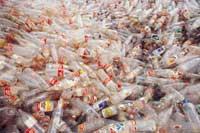What to do with multi-purpose plastic waste?
2001/11/11 Mendiburu, Joana - Elhuyar Zientziaren Komunikazioa
From the newspaper page raise your head and look at the place where you look, which if you come across some plastic. Plastics have a great lightness and manageability and that is why they are so used, but they are not so ecological. The difficulties in recycling plastics are still many, and researchers say that finally the ideal will be to produce biodegradable plastic.
Clearly we live surrounded by plastics. Everything is full of plastics, businesses, warehouses, offices, shopping carts, even agriculture. The industrial and service sectors and household waste are the main sources of plastic waste. Between the two, 93% of the volume of plastic waste is generated and the remaining 7% comes from agriculture.
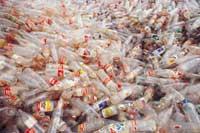
According to the report prepared by the professors and researchers of the University of the Basque Country, María José San José Alvarez and Sonia Alvarez Pérez, from 1993 to 1999, plastic consumption in the Spanish State has increased considerably. In 1992 plastic consumption per person was 59.1 kg and in 1999 102 kg. As a result, more than four million tons of plastics were produced in 1999 and 75% of urban solid waste was plastic packaging.
However, all that is used in the law of the consumer society, early or late, is to throw it away, and the case of plastic waste is no exception, but they end together with the rest of the waste or, at best, in the green or yellow container of the street.
Plastic products have a short service life, but remain in the pouring place without degrading. Therefore, instead of depositing it in landfills, experts and politicians have had to find other solutions. One of these solutions could be incineration, but emitting polluting and toxic compounds does not look with good eyes. As for recycling, it is a path full of obstacles, since in addition to the diversity of plastics, products are not always composed of a single compound. Will the solution be a biodegradable plastic?
Recycling problems
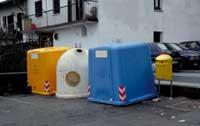
Plastic recycling forms are mechanical recycling and energy valuation. The first is the oldest system and in the 84 recycling plants in the state 10% of plastic waste is recycled. The energy valuation, on the other hand, only recycles 5%. The remaining 85% ends in landfill.
In the Autonomous Community of the Basque Country in 1994, 5,495 tons of plastic waste were generated, of which only 35.5% were recycled. Currently, thanks to recycling campaigns, this percentage has increased, but there is still no adequate infrastructure. The collection, transport and acceptance of the material are not systematized and, in addition, the quantity of plastics and their use makes recycling even more difficult.
One of the main problems for plastic recycling is that plastic gets mixed with other products to the recycling plant. For example, to recycle the polystyrene in the refrigerators, first you have to remove the liquid from the fridge, so, despite the great possibilities, it is hardly recycled. The same applies to agricultural PVC. The PVC used in the manufacture of greenhouses and polyethylene films and pipes is mixed with large amounts of land and phytosanitary products, being expensive cleaning. Industrial plastic waste, on the other hand, is well classified, little degraded and clean, constituting a very useful recycling material.
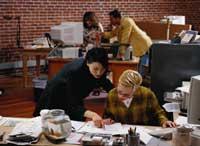
Transport is also an obstacle to recycling, especially for low-density plastics. As for the blown polystyrene, given its low density, the installation should be located near the place of obtaining the waste, since otherwise the transport costs hinder the viability of the process.
In addition to these two main barriers, it is worth mentioning the high costs of energy for recycling, the differences between national legislation, the non-acceleration in the use of recycled waste and the lack of momentum to promote recycling ideas.
When is a biodegradable plastic?
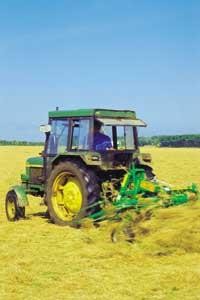
What is clear is that more and more material will be used with properties suitable for any application. But if degradation is so difficult and when burned many polluting and toxic compounds are released, what to do not harm the environment so much? The answer is the creation of a biodegradable plastic with interesting properties of plastics so far, and researchers from different laboratories are working on it. Italy has developed a 92.7% biodegradable plastic manufacturing system. This is the highest degree of biodegradability to date.
The high-level plastic manufacturing system of biodegradability has been developed by a team of scientists from the Biotechnology Department of the University of Milan. The main component is the natural cork extract that degrades in less than twenty days and also does not emit CFCs (chlorofluorocarbons) to the atmosphere. This new plastic can be broken down into water and carbon dioxide.
Professor Luca Mattia is responsible for the project. Mattia explained that the maximum level achieved in the trials carried out to date has been 60%, in all of them CFC was emitted. On this occasion they have managed to reach 92.7%, without emitting pollutants. According to experts, this plastic will be one of the most important products in the industry in the future.
Legislation on plastic waste
In Europe there is more and more waste and it is necessary to solve this problem as soon as possible. Therefore, within the framework of the Fifth Community Programme, the European Union noted that waste, in addition to being a source of pollution, should be seen as secondary raw material. Of course, for plastic waste to be useful it is essential that it be recycled previously.
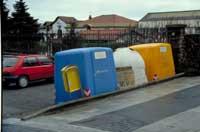
Since packaging is the main volume of waste, the European Union proposed European Legislation 94/62/EC on packaging. The objectives of this legislation are to modify the current trend towards the generation of so many waste, hierarchize waste management options (prioritize the least waste generating options and enhance recycling in cases where this is not possible) and finally, articulate support measures. States have a period of five years to implement the new law.
As a consequence of European legislation, in the Spanish State, the Packaging Waste Legislation was implemented in 1997. According to this legislation, by June 30, 2001 it was necessary to reduce at least 10% of packaging waste, recycle more than 25% and value at least 50%. In addition, each container should be recycled by 15% by weight.
At this time, in the Spanish state, half of the plastic waste that must be recycled according to European legislation is recycled, since there is no adequate planning and recycled plastic is not of the same quality as first-hand plastic. Both types of plastics compete and recycled plastics are only used when quality plastic is not needed, such as garbage bags or irrigation pipes.
Different types of plastics
PVC (Polyvinyl chloride) | In agriculture it is mainly used for the manufacture of tubes for construction or agriculture, wire roller shutter profiles, etc. |
LDPE (low density polyethylene) | Used in agriculture for the production of films and tubes and used in industry for the manufacture of industrial packages and sacks |
PP, (polypropylene) | Manufacture of fertilizer bags and manufacture of injection parts in the car |
HDPE, (high density polyethylene) | For the manufacture of injection boxes, drums and tubes |
PS (polystyrene) | For appliances and foils |
PET, (polyethylene terephthalate) | For obtaining unique and other filaments and for the manufacture of automotive parts, electrical appliances, appliances |
Published in the supplement Natura de Gara.

Gai honi buruzko eduki gehiago
Elhuyarrek garatutako teknologia




